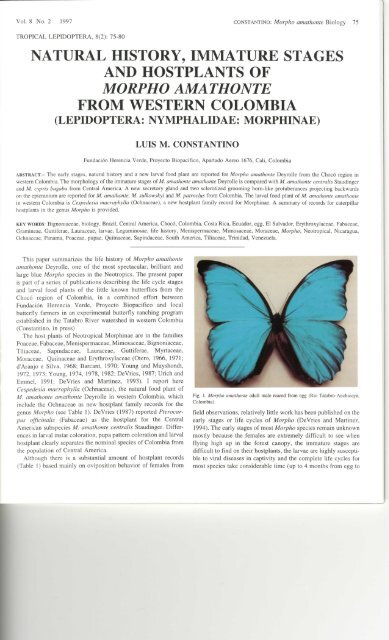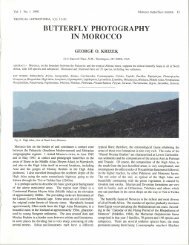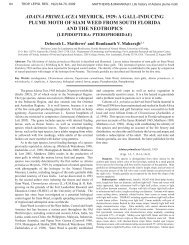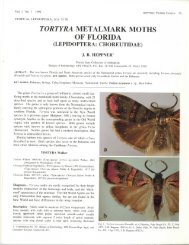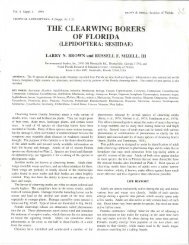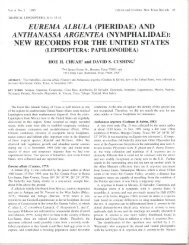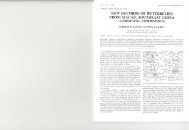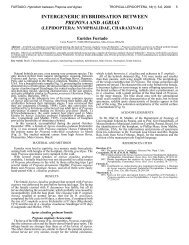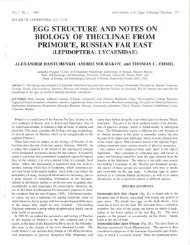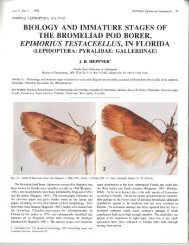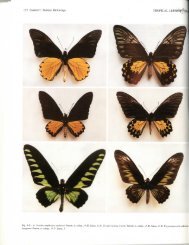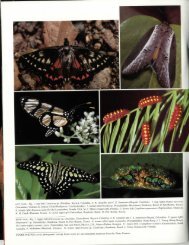natural history, immature stages and hostplants of morpho ...
natural history, immature stages and hostplants of morpho ...
natural history, immature stages and hostplants of morpho ...
You also want an ePaper? Increase the reach of your titles
YUMPU automatically turns print PDFs into web optimized ePapers that Google loves.
Vol. 8 No. 2 1997 CONSTANTINO: Morpho amathonte Biology 75TROPICAL LEPIDOPTERA, 8(2): 75-80NATURAL HISTORY, IMMATURE STAGESAND HOSTPLANTS OFMORPHO AMATHONTEFROM WESTERN COLOMBIA(LEPIDOPTERA: NYMPHALIDAE: MORPHINAE)LUIS M. CONSTANTINOFundacion Herencia Verde, Proyecto Biopacifico, Apartado Aereo 1676, Cali, ColombiaABSTRACT.- The early <strong>stages</strong>, <strong>natural</strong> <strong>history</strong> <strong>and</strong> a new larval food plant are reported for Morpho amathonte Deyrolle from the Choco region inwestern Colombia. The <strong>morpho</strong>logy <strong>of</strong> the <strong>immature</strong> <strong>stages</strong> <strong>of</strong> M. amathonte amathonte Deyrolle is compared with M. amathonte centralis Staudinger<strong>and</strong> M. cypris bugaba from Central America. A new secretory gl<strong>and</strong> <strong>and</strong> two sclerotized grooming horn-like protuberances projecting backwardson the epicranium are reported for M. amathonte, M. sulkowskyi <strong>and</strong> M. patroclus from Colombia. The larval food plant <strong>of</strong> M. amathonte amathontein western Colombia is Cespedesia macrophylla (Ochnaceae), a new hostplant family record for Morphinac. A summary <strong>of</strong> records for caterpillar<strong>hostplants</strong> in the genus Morpho is provided.KEY WORDS: Bignoniaceae, biology, Brazil, Central America, Choco, Colombia, Costa Rica, Ecuador, egg, El Salvador, Erythroxylaceae, Fabaceae,Gramineae, Guttiferae, Lauraceae, larvae, Leguminosae, life <strong>history</strong>, Menispermaceae, Mimosaceae, Moraceae, Morpho, Neotropical, Nicaragua,Ochnaceae, Panama, Poaceae, pupae, Quiinaceae, Sapindaceae, South America, Tiliaceae, Trinidad, Venezuela.This paper summarizes the life <strong>history</strong> <strong>of</strong> Morpho amathonteamathonte Deyrolle, one <strong>of</strong> the most spectacular, brilliant <strong>and</strong>large blue Morpho species in the Neotropics. The present paperis part <strong>of</strong> a series <strong>of</strong> publications describing the life cycle <strong>stages</strong><strong>and</strong> larval food plants <strong>of</strong> the little known butterflies from theChoco region <strong>of</strong> Colombia, in a combined effort betweenFundacion Herencia Verde, Proyecto Biopacifico <strong>and</strong> localbutterfly farmers in an experimental butterfly ranching programestablished in the Tatabro River watershed in western Colombia(Constantino, in press)The host plants <strong>of</strong> Neotropical Morphinae are in the familiesPoaceae, Fabaceae, Menispermaceae, Mimosaceae, Bignoniaceae,Tiliaceae, Sapindaceae, Lauraceae, Guttiferae, Myrtaceae,Moraceae, Quiinaceae <strong>and</strong> Erythroxylaceae (Otero, 1966, 1971;d'Aranjo e Silva, 1968; Barcant, 1970; Young <strong>and</strong> Muyshondt,1972, 1973; Young, 1974, 1978, 1982; DeVries, 1987; Urich <strong>and</strong>Emmel, 1991; DeVries <strong>and</strong> Martinez, 1993). I report hereCespedesia macrophylla (Ochnaceae), the <strong>natural</strong> food plant <strong>of</strong>M. amathonte amathonte Deyrolle in western Colombia, whichinclude the Ochnaceae as new hostplant family records for thegenus Morpho (see Table 1). DeVries (1987) reported Pterocarpus<strong>of</strong>ficinalis (Fabaceae) as the hostplant for the CentralAmerican subspecies M. amathonte centralis Staudinger. Differencesin larval instar coloration, pupa pattern coloration <strong>and</strong> larvalhostplant clearly separates the nominal species <strong>of</strong> Colombia fromthe population <strong>of</strong> Central America.Although there is a substantial amount <strong>of</strong> hostplant records(Table 1) based mainly on oviposition behavior <strong>of</strong> females fromFig. 1. Morpho amathonte adult male reared from egg (Rio Tatabro-Anchicaya,Colombia).field observations, relatively little work has been published on theearly <strong>stages</strong> or life cycles <strong>of</strong> Morpho (DeVries <strong>and</strong> Martinez,1994). The early <strong>stages</strong> <strong>of</strong> most Morpho species remain unknownmostly because the females are extremely difficult to see whenflying high up in the forest canopy, the <strong>immature</strong> <strong>stages</strong> aredifficult to find on their <strong>hostplants</strong>, the larvae are highly susceptibleto viral diseases in captivity <strong>and</strong> the complete life cycles formost species take considerable time (up to 4 months from egg to
76 CONSTANTINO: Morpho amathonte BiologyTROPICAL LEPIDOPTERATABLE 1. A summary <strong>of</strong> some records for caterpillar food plants in the genus Morpho.SPECIESLOCALITIESHOSTPLANT GENERAPLANT FAMILIESREFERENCESM. granadensis polybaptusM. peleides limpidaM. peleides limpidaM. peleides insularisM. achillesM. deidamiaM. laertesM. polyphemus catarinaM. polyphemus polyphemusM. catenariusM. anaxibiaM. amathonte centralisM, amathonte amathonteM. menelaus menelausM. menelaus temilimbataM. cypris bugabaM. cypris cyprisM. rhetenorM. portisM. aegaM. adonisM. sulkowskyM. rhodopteronM. herculesM. richardusM. cisseisM. hecubaM. theseus aquariusCosta RicaCosta RicaEl SalvadorTrinidadBrazilBrazilBrazilCosta RicaEl SalvadorBrazilBrazilCosta RicaColombiaBrazilBrazilCosta RicaColombiaBrazilBrazilBrazilBrazilColombiaColombiaBrazilBrazilBrazilBrazilCosta RicaMachaeriumMucuna, MachaeriumPterocarpus, LonchocarpusPlatymiscium, SwartziaDalbergia, ArachisIngaMachaeriumIngaParagoniaErythrinaPlatymiscium, MachaeriumDalbergiaPterocarpus, MyrocarpusIngaQuiinaMachaeriumIngaLucheaPaulliniaPaulliniaIngaAcaciaErythroxylumIngaGymnanthesScutiaCupania, RatoniaQuiinaErythroxylumNect<strong>and</strong>raClusiaEugeniaFicusPterocarpusCespedesiaErythroxylumMachaeriumIngaIngaMacrolobiumChusqueaChusquea, BambusaMerostachysBambusaChusqueaChusqueaAbutaAbutaAbutaUndet.Undet.FabaceaeFabaceaeFabaceaeFabaceaeFabaceaeMimosaceaeFabaceaeMimosaceaeBignoniaceaeFabaceaeFabaceaeFabaceaeFabaceaeMimosaceaeQuiinaceaeFabaceaeMimosaceaeTiliaceaeSapindaceaeSapindaceaeMimosaceaeFabaceaeErythroxylaceaeMimosaceaeEuphorbiaceaeRhamnaceaeSapindaceaeQuiinaceaeErythroxylaceaeLauraceaeGuttiferaeMyrtaceaeMoraceaeFabaceaeOchnaceaeErythroxylaceaeFabaceaeMimosaceaeMimosaceaeFabaceaePoaceaePoaceaePoaceaePoaceaePoaceaePoaceaeMenispermaceaeMenispermaceaeMenispermaceaeMenispermaceaeMenispermaceaeYoung, 1982; DeVries, 1987Young & Muyshondt, 1973DeVries, 1987DeVries, 1987Young, 1974Young, 1974Young & Muyshondt, 1973Young & Muyshondt, 1973Urich & Emmel 1991Barcant, 1970d'Aranjo e Silva,1968d'Aranjo e Silva, 1968Otero, 1971L. S. Otero (pers. comm.)L. S. Otero (pers. comm.)Otero 1971, 1966Otero, 1971. 1966d'Aranjo e Silva, 1968DeVries, 1987Young & Muyshondt, 1972Young & Muyshondt, 1972d'Aranjo e Silva, 1968d'Aranjo e Silva, 1968d'Aranjo e Silva, 1968d'Aranjo e Silva, 1968d'Aranjo e Silva, 1968d'Aranjo e Silva, 1968L. S. Otero (pers. comm.)d'Aranjo e Silva, 1968d'Aranjo e Silva, 1968d'Aranjo e Silva, 1968d'Aranjo e Silva, 1968d'Aranjo e Silva, 1968DeVries, 1987Constantino (present)d'Aranjo e Silva, 1968L. S. Otero (pers. comm.)DeVries & Martinez, 1993Rodriguez, 1993Ackery, 1988d'Aranjo e Silva, 1968d'Aranjo e Silva, 1968d'Aranjo e Silva, 1968L. S. Otero (pers. comm.)M. D. Heredia (in prep.)Salazar, 1992d'Aranjo e Silva, 1968d'Aranjo e Silva, 1968L. S. Otero (pers. comm.)L. S. Otero (pers. comm.)DeVries, 1987
78 CONSTANTINO: Morpho amathonte Biology TROPICAL LEPIDOPTERAFig. 2-5. Morpho amathonte larvae: 2) 2nd instar larva (Rio Tatabro-Anchicaya, Colombia); 3) 3rd instar secreting an oily fluid from the epicranial gl<strong>and</strong> after beingmolested; 4) 4th instar larva (dorsal view) on hostplant C. macrophylla; 5) 4th instar larva (lateral view).Fourth instar larvae (Fig. 4-5): The 4th instar larva is about 7cm.Head: the head capsule is now pale brown, sparsely hairy <strong>and</strong> with twogray vertical lines on the face. The head capsule is now less wide thanbody. Body overall color now yellow-green in the dorsal ovals <strong>and</strong> aconspicuous "x" pattern between the two ovals. Lateral side <strong>of</strong> body nowwith fine filigree cream <strong>and</strong> pale maroon patterns. Dorso lateral tufts <strong>of</strong>hair shorter, especially on segments T-l to T-2 <strong>and</strong> A-l which arecompletely red. The total 4th instar duration is 18 days.Fifth instar larvae: The last instar larva attains a body lenght <strong>of</strong> about10cm. The body is now wider than the head. The general appearance <strong>of</strong>the 5th instar larva is very similar to that <strong>of</strong> the previous instar, but thebody assumes a thicker pr<strong>of</strong>ile, <strong>and</strong> the annules on the body segmentsare more prominent. Body now with lime-green ovals with dark red linesbetween the ovals <strong>and</strong> along the sides. The lateral side <strong>of</strong> body stillyellow but with gray-maroon marks <strong>and</strong> patterns. Total 5th instarduration is 19 days.Prepupa: at this stage the larva stops feeding <strong>and</strong> loses all traces <strong>of</strong>yellow <strong>and</strong> red becoming completely dull green. The prepupal stage lasts4 days.Pupa (Fig. 6): pale green, ovoid, head area slightly bifid with whiteareas surrounding the spiracles, in addition to a conspicuous semicircularwhite b<strong>and</strong> that covers laterally the dorsal area <strong>of</strong> segment A-6. Thereis no noticeable change in the coloration <strong>of</strong> the pupa as the adultdevelops, although usually within 24 hours <strong>of</strong> eclosion, the wingpadsdarkens strongly <strong>and</strong> the abdominal segment between A-5 <strong>and</strong> A-6become loose <strong>and</strong> slightly separated. The pupal stage lasts 19 days.Fig. 6. Morpho amathonte, pupal shell.Larval Behavior <strong>and</strong> Secretory Gl<strong>and</strong>sThe larvae are solitary, feeding during the early morning hours<strong>and</strong> during the night. When not feeding, the larvae rest at alltimes at the base undersides <strong>of</strong> large leaves. The larvae <strong>of</strong>
Vol. 8 No. 2 1997 CONSTANTINO: Morpho amathonte Biology 79Morpho possess at least two secretory gl<strong>and</strong>s: the cervical gl<strong>and</strong>,located anterior to the first set <strong>of</strong> legs, extruded when a caterpillaris molested <strong>and</strong> which emits a strong odor, <strong>and</strong> the groominggl<strong>and</strong>, located between the subdorsal tufts on segment A-l, whichsecretes a liquid that is groomed into the subdorsal tufts <strong>of</strong> setae.Both secretory gl<strong>and</strong>s are likely to serve a defensive function(DeVries <strong>and</strong> Martinez, 1993). A new gl<strong>and</strong>, termed here as theepicranial gl<strong>and</strong> which has apparently never been describedpreviously, secretes a drop <strong>of</strong> a clear oily fluid from a dorsal porelocated on the epicranium (Fig. 3) which is then combed into thevarious tufts <strong>of</strong> setae along the body. The larvae is able to retainthe drop <strong>of</strong> the fluid on a groove located on the epicranium. Thegroove is bifurcated at the end in two sclerotized sharp spikesprojected backwards. These spikes or small horns are used tocomb the oily fluid into the subdorsal abdominal tufts <strong>of</strong> setae.Usually, the spikes are difficult to see in live larvae because theyare concealed by the setae on the head capsule, but can be seeneasily under the microscope in the head capsules <strong>of</strong> all instarsthat have been preserved in alcohol. When larvae are molested,they lift the head backwards, <strong>and</strong> the drop <strong>of</strong> liquid is combedinto the subdorsal setae on T-l <strong>and</strong> T-2. Then with a slow,rotating motion <strong>of</strong> the head, the drop is combed into all abdominalsubdorsal tufts <strong>and</strong> setae. This oily substance acts as an insectrepellent against parasitic wasps <strong>and</strong> ants, in addition to being awater repellent. The epicranial gl<strong>and</strong> <strong>and</strong> sclerotized spikesprojected backwards have been observed also in two other species<strong>of</strong> Morpho caterpillars in Colombia: M. sulkowskyi <strong>and</strong> M,patroclus (M. D. Heredia, in prep.; L. M. Constantino, pers.observ.)Life cycleThe complete life cycle <strong>of</strong> M. amathonte requires about 120days (4 months) from egg to adult, with the egg lasting 14 days,the larvae about 83 days, the prepupal stage 4 days, <strong>and</strong> the pupa19 days.HostsCespedesia macrophylla <strong>and</strong> C. spathulata (Ochnaceae), inwestern Colombia.ACKNOWLEDGMENTSAll photographs in this paper were taken by GermSn Ramirez <strong>and</strong>Guillermo Guzman (CIAT, Palmira) from life <strong>history</strong> <strong>stages</strong> reared bythe author in Colombia. I wish to thank also butterfly farmers Juan deDios Ramos (COAGRITA, Tatabro), Justine Angulo <strong>and</strong> Te<strong>of</strong>iloCamacho (Tatabro), for assistance in caring for the early <strong>stages</strong> <strong>and</strong> forfield work. A special thanks to Jacob Ol<strong>and</strong>er (Ecuador), Juan C.Riascos, Andres Alarc6n, Emilio Constantino (Fundaci6n HerenciaVerde, Cali), Fern<strong>and</strong>o Cast (Proyecto Biopacifico), <strong>and</strong> Ma. DoloresHeredia (Cali) for advice. Thanks also to Luiz S. Otero (Brazil) forproviding some important references <strong>and</strong> hostplant records <strong>of</strong> Morphospecies. This series <strong>of</strong> butterfly life <strong>history</strong> studies is part <strong>of</strong> the projecton butterfly farming by the Anchicaya River, supported by FundacionHerencia Verde (FHV) <strong>and</strong> Proyecto Biopacifico (PBP), Ministerio delMedio Ambiente, PNUD-GEF-Col/92/G31.LITERATURE CITEDAckery, P. R.1988. Host plants <strong>and</strong> classification: a review <strong>of</strong> nymphalid butterflies.Biol. J. Linn. Soc. (London), 33:95-203.Barcant, M.1970. Butterflies <strong>of</strong> Trinidad <strong>and</strong> Tobago. London: Collins. 350pp.Constantino, L.M.1992. Paradulcedo, a new genus <strong>of</strong> Satyrinae (Nymphalidae) fromwestern Colombia. J. Lepid. Soc. (Los Angeles), 46:44-53.1993. Notes on Haetera from Colombia, with descriptions <strong>of</strong> the<strong>immature</strong> <strong>stages</strong> <strong>of</strong> Haetera piera (Nymphalidae: Satyrinae).Trap. Lepid. (Gainesville), 4:13-15.1995. Revision de la tribu Haeterini Herrich-Schaffer, 1864 enColombia (Nymphalidae, Satyrinae). SHILAP Revta. Lepid.(Madrid), 23:49-76.[in press]. Butterfly life <strong>history</strong> studies, diversity, ranching <strong>and</strong>conservation in the Choc6 rain forests <strong>of</strong> western Colombia.SHILAP Revta. Lepid.(Madrid).D'Abrera, B.1984. Butterflies <strong>of</strong> the Neotropical Region, Part II. Danaidae,Ithomiidae, Heliconidae & Morphidae. Hill House, Victoria.232pp.d'Aranjo e Silva, A. G., C. R. Conceives, D. M. Galvao, A. J. L.Conceives, J. Gomes, M. N. Silva, <strong>and</strong> L. Simoni1968. Quarto catalogo dos insectos que vivem nas plantas do Brasil;seus parasitas e predadores. Rio de Janeiro: Minist. Agric.265pp.DeVries, P. J.1987. The Butterflies <strong>of</strong> Costa Rica <strong>and</strong> their Natural History. [I]:Papilionidae, Pieridae, Nymphalidae. Princeton: PrincetonUniv Press. 327pp.DeVries, P. J., <strong>and</strong> G. E. Martinez1993. The <strong>morpho</strong>logy, <strong>natural</strong> <strong>history</strong>, <strong>and</strong> behavior <strong>of</strong> the early<strong>stages</strong> <strong>of</strong> Morpho cypris (Nymphalidae: Morphinae) - 140years after formal recognition <strong>of</strong> the butterfly. J. New York.Ent. Soc., 101:515-530.Gentry, A.1993. A Field Guide to the Families <strong>and</strong> Genera <strong>of</strong> Woody Plants <strong>of</strong>Northwest South America. Washington: Conservation Intl. 895pp.Kruger, E.1924-25. Die Morphiden Columbiens nebst e inigen allgemeinenBemerkungen iiber Morphiden. Dtsch. Ent. Zeit. Iris (Dresden),38:23-39, 99-132, 223-268.LeMoult, E., <strong>and</strong> P. Real1963. Les Morpho d'Amerique du Sud et Centrale. Tome II. Paris:Edit. Le Moult. 296pp.Otero, L. S.1966. Biologic de sept Lepidopteres Bresiliens du genre MorphoFabricius, 1807. Ph.D. thesis, University <strong>of</strong> Paris. 306pp.1971. Instrucoes para criacao da borboleta "Capitao-do-mato"Morpho achillaena e outras especies do genera Morpho ("azulseda,""azulao-branco," "prain gr<strong>and</strong>i"). Rio de Janeiro: Inst.Brasil. Desenvolv. Florestal. 27pp.Rodriguez, M.1993. Contribuci6n al conocimiento de las mariposas del generoMorpho (Nymphalidae: Morphinae) de Colombia. BSc. thesis,Univ. Nac., Bogota. 250pp.Salazar, J. A.1992. Contribuci6n al conocimiento de los Morphinae Colombianos.Localizaci6n de una poblacion de Morpho rhodopteron
80 CONSTANTINO: Morpho amathonte Biology TROPICAL LEPIDOPTERA(Godman & Slavin, 1880) en Colombia. SHILAP Rvta. Lepid.(Madrid), 20:167-171.Urich, F. C., <strong>and</strong> T. Emmel1991. Life histories <strong>of</strong> Neotropical butterflies from Trinidad 3.Morpho peleides insularis (Nymphalidae: Morphinae). Trap.Lepid, (Gainesville), 2:137-139.Young, A.1974. The rearing <strong>of</strong> the Neotropical butterfly Morpho peleides(Nymphalidae) on peanuts. J. Lepid. Soc. (Los Angeles), 28:90-99.1978. Studies on the interactions <strong>of</strong> Morpho peleides (Morphidae)with Leguminosae. J. Lepid. Soc. (Los Angeles), 32:65-74.1982. Notes on the <strong>natural</strong> <strong>history</strong> <strong>of</strong> Morpho granadensis polybaptusButler (Nymphalidae: Morphinae), <strong>and</strong> its relation to that <strong>of</strong>Morpho peleides limpida Butler. J. New York. Ent. Soc., 90:35-54.Young, A., <strong>and</strong> A. Muyshondt1972. Biology <strong>of</strong> Morpho polyphemus (Lepidoptera: Morphidae) inEl Salvador. / New York Ent. Soc., 80:18-42.1973. The biology <strong>of</strong> Morpho peleides in Central America. Carib. J.Sci. (Mayaguez), 13:1-49.


